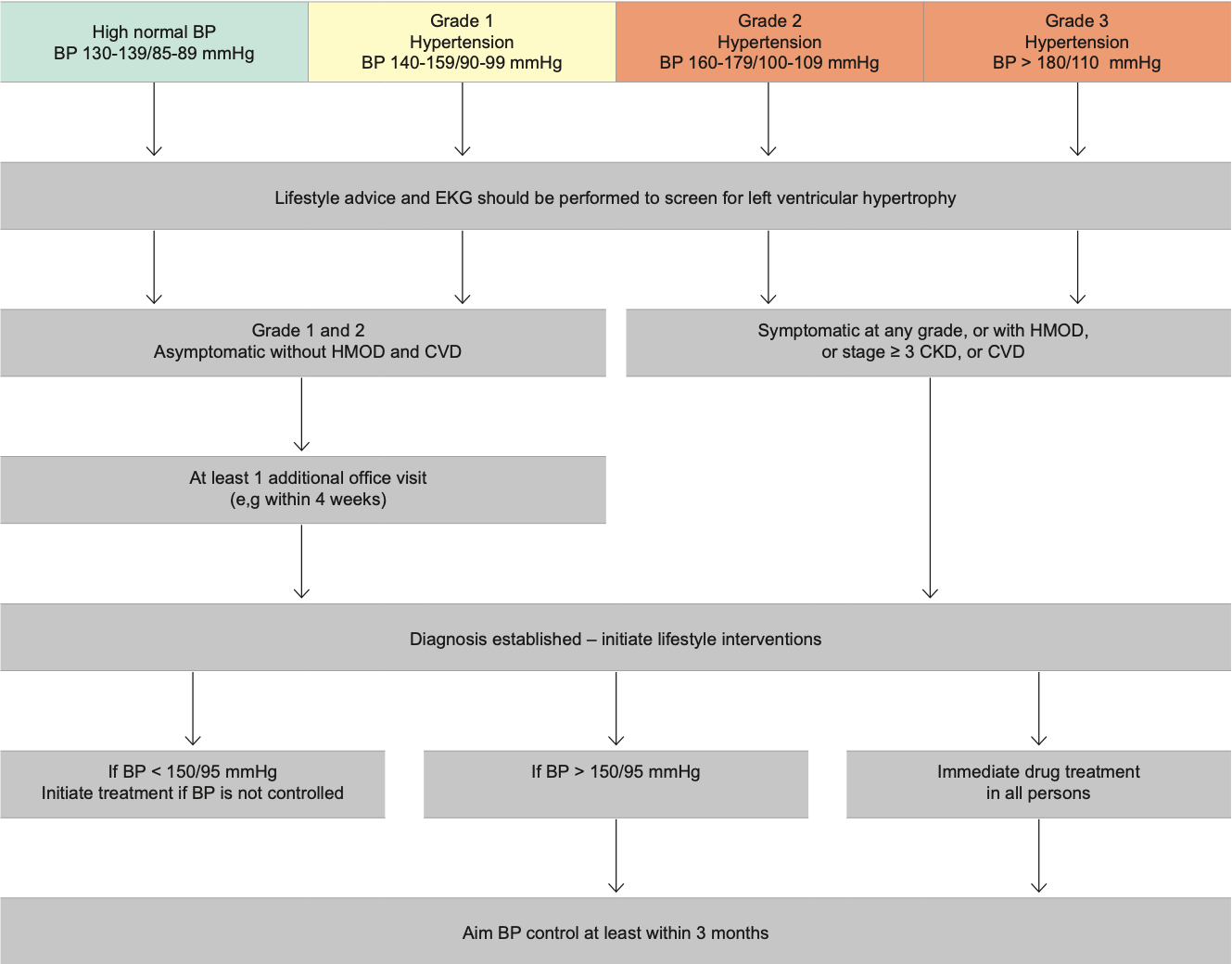Hypertension: Diagnosis, Grading & Management
Hypertension Diagnosis, Grading and Management

Initiation of blood pressure-lowering treatment (lifestyle changes and medication) at different initial office blood pressure levels
Use home blood pressure monitoring (HBPM) and/or ambulatory blood pressure monitoring (24h ABPM) whenever possible.
Abbreviations:
BP = blood pressure;
CAD = coronary artery disease;
CVD = cardiovascular disease;
HMOD = hypertension-mediated organ damage.
Adapted from The Task Force for the management of arterial hypertension of the European Society of Hypertension (ESH). Journal of Hypertension 2023, 41: 1874–2071.
Hypertension-mediated organ damage (HMOD)
- Increased large artery stiffness:
Pulse pressure (in older people) > 60mmHg and/or carotid–femoral pulse wave velocity >10 m/s (if available) - Presence of non-hemodynamically significant atheromatous plaque (stenosis) on imaging
- Left ventricle hypertrophy on electrocardiogram (EKG) or on echocardiography
- Moderate increase of albuminuria 30–300 mg/24 h or elevated ACR (preferably in morning spot urine) 30–300 mg/g
- CKD stage 3 with eGFR 30–59 ml/min/1.73m2
- Ankle–brachial index <0.9
- Advanced retinopathy: haemorrhages or exudates, papilloedema
How to measure blood pressure (BP)
Patients should be seated comfortably in a quiet environment for 5 minutes before beginning BP measurements. Three BP measurements should be recorded, 1-2 min apart, and additional measurements only if the first two readings differ by >10 mmHg. BP is recorded as the average of the last two BP readings. Use a standard bladder cuff (12-13 cm wide and 35 cm long) for most patients but have larger and smaller cuffs available for larger (arm circumference > 32 cm) and thinner arms, respectively.
Hypertension in clinic should be confirmed with home BP measurement or 24hr ambulatory BP monitoring if a white coat effect is evoked.
Comparison of ambulatory blood pressure monitoring (24h ABPM) and home blood pressure monitoring (HBPM)
| 24h ABPM | HBPM |
| Advantages • Can identify white coat and masked hypertension • Night time readings • Real life setting • BP variability • Prognosis value (no deeper) • Suspicion of sleep apnea syndrome (no deeper) |
Advantages • Can identify white coat and masked hypertension • Cheap and widely available • Patient engagement in BP measurement • Easily repeated |
| Disadvantages • Expensive • Sometimes uncomfortable |
Disadvantages • Only static BP • Potential measurement error • No nocturnal readings |
Where available, please refer to national hypertension guidelines for further information
Adapted from the 2021 European Society of Hypertension practice guidelines for office and out-of-office blood pressure measurement. Journal of Hypertension 2021, 39(7): 1293-1302
